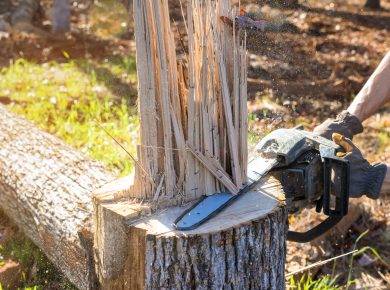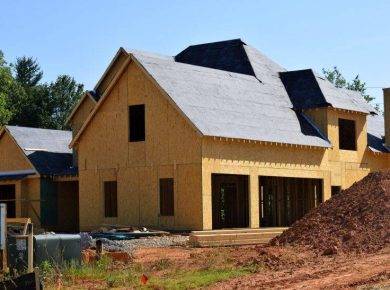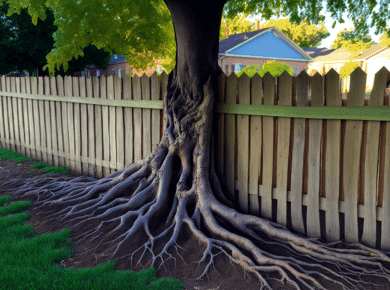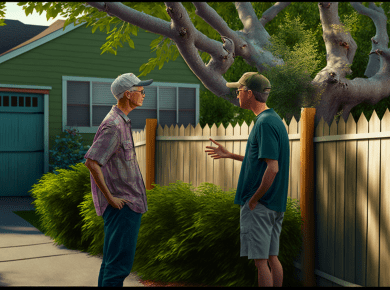Table of Contents
- A neighbor cut down my tree in Wyoming
- My neighbor cut my tree in Wyoming
- My tree branches overhang my property in Wyoming
- My neighbor damaged my tree on my property in Wyoming
- My neighbor’s tree roots or branches damaged my property in Wyoming
- Can my neighbor make me cut my tree?
- How can I get my neighbor to cut his dead tree in Wyoming?
- What happens if I cut my neighbor’s tree down in Wyoming?
- If a tree is cut down on my property by a neighbor how much money should I receive in damages?
- If your property was damaged click here to see if you might have a case.
A neighbor cut down my tree in Wyoming
No one wants to come outside and find a beloved tree on their property removed without their permission, especially when it was a neighbor who took it upon themselves to do the job. If you’ve experienced this situation in Wyoming, it’s important to know what steps to take to ensure that justice is served.
The first thing to do is to check in with local ordinances. Each city or county may have their own rules and regulations regarding cutting down trees, so it’s important to know what the law says. If the cutting of your tree is against local ordinances, you should file a complaint with your city or county office.
Next, document the event with pictures and videos. This will be exceedingly helpful if your case ends up going to court. You also should make sure to save copies of any correspondence with your neighbor.
Finally, you may want to consider consulting with a lawyer in your area who practices in these kinds of cases. You may have legal grounds to take your neighbor to court or even tie their action to the local ordinances.
Regardless of the route you decide to take, a lawyer can help you make sure that your rights are upheld and justice is served. With the right legal support, you can be sure that the matter will be handled fairly and with due diligence.
By following these steps, you can ensure that you get the justice you deserve when a neighbor cuts down your tree in Wyoming. If you would like legal advice, contact a lawyer in your area who practices in cases involving neighbors cutting down trees. They can provide you with guidance on the best course of action and make sure your rights are respected.
My neighbor cut my tree in Wyoming
Living in Wyoming presents unique challenges and rewards, especially when it comes to managing trees and landscaping. One common issue that homeowners may experience is a neighbor cutting a tree without permission. While it may be a violation of local codes, it is important to handle the situation with respect and fairness.
The first step to take is to assess the damage. Document the incident as much as possible, taking pictures and reporting information to the local authorities if necessary. Your neighbor should also be informed of the situation, as it is important to maintain open communication lines.
The next step is to determine what legal repercussions your neighbor may face for their actions. Speak with the local authorities and review local codes to understand the potential legal ramifications. Additionally, consider if your neighbor should financially compensate you for the damage done to the tree. Discuss a solution that both parties are comfortable with and make sure that all steps are followed.
Finally, make sure your tree is properly cared for. Speak with an experienced arborist to assess the damage and advise on the best way to care for the tree moving forward. Follow their instructions and make sure that your neighbor knows that you are taking the necessary steps to protect your tree.
By carefully addressing the situation and following the required steps, you can help to resolve the problem and maintain a good relationship with your neighbor.
My tree branches overhang my property in Wyoming
When tree branches overhang your property in Wyoming, it is important to maintain a safe and clean environment for you and your property. Tree disturbances, such as overhanging branches, can affect the safety and cleanliness of the surrounding area and the foundation of your property. In the state of Wyoming, there is a specific law regarding this kind of issue.
Whenever there is an overhanging tree branch, Wyoming law requires landowners to trim or remove the encroaching tree branches. If a property owner fails to act, the neighbor whose property is affected can file a legal complaint and seek compensation from the responsible party. Wyoming law states that when a “person’s tree or shrub encroaches over the boundary lines of his land to the branches of a tree owned by another party, the owner of the encroached upon tree shall have the right to trim the tree so that it will no longer encroach over the boundary line.”
When trimming a tree to remove overhanging branches in Wyoming, it is important to contact an experienced arborist before starting the process. An arborist can help determine the best way to safely trim the tree, while minimizing its possible damage. Depending on the situation and type of tree it may be necessary to take down the entire tree or just portions of it, so great care must be taken to ensure that the surrounding environment is preserved.
Ultimately, maintaining trees on your property in Wyoming is important for both your safety and for the preservation of the local environment. When tree branches begin to encroach over your property boundaries, it is important to act quickly and contact an experienced arborist to handle the job. Taking the time to adhere to Wyoming’s tree regulations can help protect your property, while also allowing you to keep the natural environment around your home intact.
My neighbor damaged my tree on my property in Wyoming
If your neighbor damages or removes a tree or any vegetation from your property in Wyoming, you may be entitled to compensation. The amount of compensation depends on whether the tree had economic value or was damaged in an intentional act.
To determine if your tree is entitled to compensation, you should first find out the tree’s value. Talk to a certified arborist or horticulturist familiar with the species of tree to estimate the value. Make sure you take pictures of any damage before you make any claims.
You should also check local ordinances and homeowners association rules to see if your tree is protected by any laws. If so, you may be entitled to damages beyond the value of the tree.
If you determine that your neighbor is guilty of a criminal act (such as malicious destruction of property), you should contact the local police or the Wyoming Attorney General’s Office for assistance in filing a criminal complaint.
If you believe your neighbor is liable for civil damages, you should take your evidence to a lawyer for a consultation. It is also possible to file in small claims court if your damages don’t exceed $7,000.
Under Wyoming law, you may also be able to sue your neighbor for trespass. This would depend on whether your neighbor had permission to be on your property.
Enforcing your legal rights in a case involving trees and other vegetation can be complicated. As such, it is recommended that you speak to a lawyer to make sure you are taking the right steps.
My neighbor’s tree roots or branches damaged my property in Wyoming
If you live in Wyoming and your neighbor’s tree roots or branches have damaged your property, you may be able to seek compensation for any damage that’s incurred.
First, you need to determine if the damage was due to the homeowner’s negligence or the natural growth of the tree. It’s important to note that, typically, damage caused by natural growth isn’t the responsibility of the homeowner and won’t result in compensation. So if the damage is likely from natural growth, such as a tree falling due to bad weather, then it’s unlikely that you’ll receive compensation for the damage caused.
If the damage was due to the homeowner’s neglect, then you may be able to seek compensation for any costs associated with the repair. To obtain compensation, it’s best to document the damage and submit a written claim to the homeowner’s insurance company.
In some cases, it might be necessary to take the homeowner to court over the tree damage. This is especially true if the homeowner is being uncooperative or refuses to compensate the cost of repairs. In this event, it may be necessary to hire a lawyer who can help you build your case and represent you in court.
Finally, if nothing else works, it may be necessary to contact local authorities. In some cases, they may be able to enforce an action or offer assistance and resources that you may not have been aware of.
No matter how your neighbor’s tree has damaged your property, you should take steps to protect yourself from any further damage. This may mean requesting that the owner take measures to correct the issue or trimming any branches that appear to be growing onto your property.
By taking the necessary steps to protect your property and seeking compensation for any damage that does occur, you can help ensure that you are fairly compensated for the damage caused by your neighbor’s tree.
Can my neighbor make me cut my tree?
Tree ownership and responsibility can vary depending on what kind of property you own and the nature of the tree. In some situations, a tree can be legally contested if it stands on a boundary line between two properties, or encroaches upon the property of another.
The first step to understand if a tree can be contested is to determine if the tree is actually on your neighbor’s property. If the tree is found to be on your neighbor’s property, then your neighbor may be legally entitled to request for it to be cut down or trimmed back. There may also be circumstances in which a tree could be damaging your neighbor’s property and they could then have cause to file a lawsuit against you.
The best course of action which can be taken prior to any legal action being taken is to talk to your neighbor. Most disagreements can be resolved through respectful, courteous and diplomatic communication. Furthermore, it is important to remember to apply common courtesy when any type of tree removal is necessary.
In some states, there are rules and regulations that may apply to tree ownership and removal. For instance, in California, a tree owned by the homeowner is the responsibility of the homeowner in the case of any damage or harm it may cause. Additionally, in some states there are required permits which must be obtained prior to cutting down a tree. Therefore, it is important to check your local laws and make sure you are not violating any regulations.
Therefore, before your neighbor makes any legal requests it is important to discuss with them the possibility of cutting back the tree. Additionally, figuring out who owns the tree, whether the tree is causing damage, and the various laws and regulations which may apply is essential to understanding if a neighbor can force you to cut your tree.
How can I get my neighbor to cut his dead tree in Wyoming?
Getting your neighbor to agree to have a dead tree removed from their property can be a tough task, especially in Wyoming. Before you bring the issue to your neighbor, you should first take the time to fully assess the safety risks the tree presents. If you do not feel the tree is an immediate risk, it is best to be patient, courteous, and move forward with caution.
Step 1:
Before you approach your neighbor, it is important to understand the local regulations governing tree removal. Wyoming has strict regulations when it comes to tree removal – primarily because in many areas of the state, trees are a source of income for private landowners. Contact your local county extension office and they will be able to provide information on this.
Step 2:
Contact the property owner and express your concerns in a polite and understanding manner. Explain that you are concerned about the potential safety risks the dead tree could cause and why it would be best to have it removed.
Step 3:
Offer to help with the removal process. If the cost of removing the tree is a concern for the property owner, you could offer to help reduce this cost by helping with the labor.
Step 4:
Provide evidence that the tree needs to be removed. If the property owner is still not convinced, you could take them to see the tree and point out the potential safety risks it presents. If the tree is unstable or presents signs of decay, this may be the final straw that convinces them the tree needs to be removed.
Step 5:
Hire a professional arborist to assess and remove the tree. Wyoming has many certified arborists who can help assess the risk and perform the tree removal. Be sure to find an arborist with experience in dead tree removal and make sure they are adequately insured.
By following these steps and taking the time to understand the regulations and safety risks associated with the tree, you should be able to convince your neighbor to have it removed. Good luck!
What happens if I cut my neighbor’s tree down in Wyoming?
If you cut down your neighbor’s tree in Wyoming without their permission, you could face criminal charges. It is considered to be a form of criminal mischief, a misdemeanor offense. If the tree was of considerable value, you could even face felony charges. The charges and potential legal consequences depend on the type and value of the tree and how much damage occurred.
The first step in prosecution of this offense is typically civil litigation. The injured party, your neighbor, could bring a civil lawsuit against you for occurrence of damages as a result of cutting down the tree without their consent. In the civil lawsuit, your neighbor could seek financial compensation for damages, such as the value of the tree, costs for replacement and removing the tree, and any additional costs resulting from the tree’s removal. Depending on the case, your neighbor could additionally seek punitive damages from you including fines, to discourage such behavior in the future.
If you are convicted of criminal mischief, criminal penalties can include jail time, fines, and restitution. If convicted of a felony, prison time, court costs, and possible restrictions on your personal freedoms can be added to the punishment. In addition, the offense can appear on your criminal record and the civil court could award additional damages.
To avoid these issues, it is important that you gain prior written permission from your neighbor before cutting down any trees. Always consult local ordinances and regulations as well before taking any action. Also, if you need to do tree trimming or removal, contact an arborist to do the job instead.
If a tree is cut down on my property by a neighbor how much money should I receive in damages?
The damages you receive will depend on the value of the tree prior to its destruction. This can be determined by several factors, including the tree’s species, size, health, and location. The cost to replace the tree or remove its stump will also be taken into consideration. Finally, local ordinances may provide guidance when determining how much your neighbor should pay you for your lost tree.



